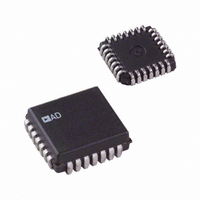AD7828KP Analog Devices Inc, AD7828KP Datasheet - Page 7

AD7828KP
Manufacturer Part Number
AD7828KP
Description
IC ADC 8BIT LC2MOS 8CH 28-PLCC
Manufacturer
Analog Devices Inc
Datasheet
1.AD7828LRS-REEL.pdf
(16 pages)
Specifications of AD7828KP
Data Interface
Parallel
Rohs Status
RoHS non-compliant
Number Of Bits
8
Sampling Rate (per Second)
50k
Number Of Converters
3
Power Dissipation (max)
100mW
Voltage Supply Source
Single Supply
Operating Temperature
0°C ~ 70°C
Mounting Type
Surface Mount
Package / Case
28-LCC (J-Lead)
Resolution (bits)
8bit
Sampling Rate
50kSPS
Input Channel Type
Differential
Supply Voltage Range - Analog
4.75V To 5.25V
Supply Current
16mA
Digital Ic Case Style
LCC
Lead Free Status / RoHS Status
Contains lead / RoHS non-compliant
Available stocks
Company
Part Number
Manufacturer
Quantity
Price
Company:
Part Number:
AD7828KP
Manufacturer:
AD
Quantity:
1 010
Part Number:
AD7828KP
Manufacturer:
ADI/亚德诺
Quantity:
20 000
Company:
Part Number:
AD7828KP-REEL
Manufacturer:
Analog Devices Inc
Quantity:
10 000
Company:
Part Number:
AD7828KPZ
Manufacturer:
Analog Devices Inc
Quantity:
10 000
Part Number:
AD7828KPZ
Manufacturer:
ADI/亚德诺
Quantity:
20 000
REV. F
INPUT CURRENT
Due to the novel conversion techniques employed by the AD7824/
AD7828, the analog input behaves somewhat differently than in
conventional devices. The ADC’s sampled-data comparators
take varying amounts of input current depending on which cycle
the conversion is in.
The equivalent input circuit of the AD7824/AD7828 is shown
in Figure 8. When a conversion starts (CS and RD going low),
all input switches close, and the selected input channel is con-
nected to the most significant and least significant comparators.
Therefore, the analog input is simultaneously connected to
31 input capacitors of 1 pF each.
The input capacitors must charge to the input voltage through
the on resistance of the analog switches (about 3 kΩ to 6 kΩ). In
addition, about 14 pF of input stray capacitance must be charged.
The analog input for any channel can be modelled as an RC
network, as shown in Figure 9. As R
for the input capacitance to charge.
The time for which the input comparators track the analog input
is approximately 1 µs at the start of conversion. Because of input
transients on the analog inputs, it is recommended that a source
impedance no greater than 100 Ω be connected to the analog
inputs. The output impedance of an op amp is equal to the open
loop output impedance divided by the loop gain at the frequency of
V
Figure 8. AD7824/AD7828 Equivalent Input Circuit
IN
V
IN
R
S
R
AIN1
S
Figure 9. RC Network Model
AD7824/
AD7828
AIN1
R MUX
12pF
C
S
C
12pF
R MUX
S1
800
C
2pF
R
LADDER
R
LADDER
ON
ON
S
TO MS
TO LS
C
2pF
S
S2
350
R
increases, it takes longer
ON
COMPARATORS
COMPARATORS
16MSB
15LSB
31pF
1pF
1pF
•
•
•
•
•
•
1pF
1pF
–7–
interest. It is important that the amplifier driving the AD7824/
AD7828 analog inputs have sufficient loop gain at the input signal
frequency as to make the output impedance low.
Suitable op amps for driving the AD7824/AD7828 are the AD544
or AD644.
INHERENT SAMPLE-HOLD
A major benefit of the AD7824’s and AD7828’s analog input
structure is its ability to measure a variety of high speed signals
without the help of an external sample-and-hold. In a conven-
tional SAR type converter, regardless of its speed, the input
must remain stable to at least 1/2 LSB throughout the conversion
process if rated accuracy is to be maintained. Consequently, for
many high speed signals, this signal must be externally sampled
and held stationary during the conversion. The AD7824/AD7828
input comparators, by nature of their input switching, inherently
accomplish this sample-and-hold function. Although the conver-
sion time for AD7824/AD7828 is 2 µs, the time for which any
selected analog input must be 1/2 LSB stable is much smaller.
The AD7824/AD7828 tracks the selected input channel for
approximately 1 µs after conversion start. The value of the analog
input at that instant (1 µs from conversion start) is the measured
value. This value is then used in the least significant flash to
generate the lower four bits of data.
SINUSOIDAL INPUTS
The AD7824/AD7828 can measure input signals with slew rates
as high as 157 mV/µs to the rated specifications. This means that
the analog input frequency can be up to 10 kHz without the aid
of an external sample-and-hold. Furthermore, the AD7828 can
measure eight 10 kHz signals without a sample-and-hold. The
Nyquist criterion requires that the sampling rate be twice the
input frequency (i.e., 2 × 10 kHz). This requires an ideal anti-
aliasing filter with an infinite roll-off. To ease the problem of
antialiasing filter design, the sampling rate is usually much greater
than the Nyquist criterion. The maximum sampling rate (F
for the AD7824/AD7828 can be calculated as follows:
t
t
This permits a maximum sampling rate of 50 kHz for each of
the eight channels when using the AD7828 and 100 kHz for
each of the four channels when using the AD7824.
CRD
P
= Minimum Delay Between Conversion
= AD7824/AD7828 Conversion Time
F
F
MAX
MAX
=
=
t
2
CRD
E
1
–
+
6
t
+
P
1
0 5
.
E
–
AD7824/AD7828
6
=
400
kHz
MAX
)













